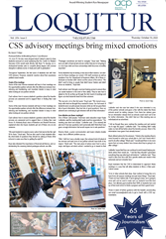by Kate Pelusi
staff writer
Seniors might want to hold off on a shiny new car after graduation or an ultra-chic new apartment when they see how much money in loans they may need to pay back.
According to an article in the Chronicle of Higher Education, students are going into debt and do not realize how much they will need to pay back after graduation.
There are various types of loans. First, a Perkins Loan is granted based upon a student’s need and also requires the student to be attending school at least half-time. The interest rate on a Perkins Loan is fixed at 5 percent and $3,000 is the maximum amount loaned. The grace period begins nine months after the student drops below half-time, graduates, or leaves school.
A subsidized Stafford Loan is also based on need and requires half-time status. The interest rate is variable with an 8.25 percent cap. The maximum amount increases while a student continues school. Year one, $2,625 is the maximum; $3,500 for year two and $5,500 for years three through five. The grace period begins six months after a student drops below half-time, graduates, or leaves school. Students also have up to 10 years to repay this loan in full.
An unsubsidized Stafford Loan is not based on need, but still requires half-time status. This loan is designed to help students who do not qualify for any other types of financial aid, but still need assistance in paying for tuition. The interest rate, maximum loans, and grace periods are identical to a subsidized Stafford Loan.
Another type of loan is an unsubsidized Stafford Loan for independent students. The student most either be either an independent student or a dependent student whose parents were denied a Federal PLUS loan. A student can receive a possible maximum annual loan amount of $23,000 for undergraduate studies and $73,000 for graduate studies. Up to 10 years is given to repay this loan with a minimum monthly payment of $50.
A Federal PLUS loan gives money to the parents of a dependent half-time or full-time student. The maximum amount of tuition minus any other financial aid is loaned and a Federal PLUS loan must be repaid within 10 years with a minimum monthly payment of $50.
According to the Chronicle for Higher Education, eight out of 10 students surveyed underestimated the total cost of their loans. The article mentioned that students underestimated these costs because they did not understand the impact the interest had on loans.
It was found that students were off in their estimations
The article also reported that Rep. George Miller of California (D.-CA) is supporting efforts to eliminate fees required by the government in order for a student to receive a loan.
“When I am done school, I’ll get a job and pay off my loans before I go to graduate school,” said junior biology major Kathleen McCarthy.
Angela Thornton, senior human resources major commented, “I’ll just pay of the loans by making the monthly payments.”
Student Loans are an excellent way to make a college education possible. However, it is never too late to begin to set aside some money each week in preparation for paying back loans after graduation.


